This is a free fortnightly newsletter about the New Zealand Net. If you would like to be notified by email when a new edition is published, please contact ZL1NZ.
Browse our Newsletter Archive and List of Net Tips.
Featured key
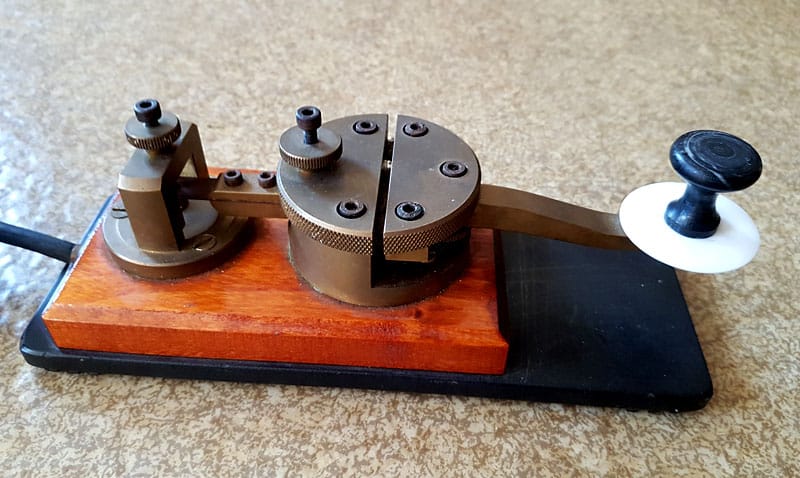
PP-500 key from Finland. Photo: SM5LNE
By Jan SM5LNE
Here is an interesting Army morse key PP-500, made in 1988 by the Finnish Army Signal Depot.
The key is all brass on a heavy steel base plate weighing 1.89kg. The arm is pivoting by a steel blade, as on the “Swedish key”.
I think they are very uncommon. My key has s/n 94385 and handles very nicely
* If you have an interesting key for this feature, please send me a nice clear photo and a few words describing it.
Quick notes
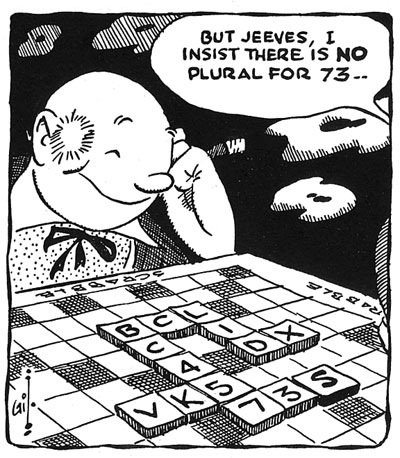 This is issue 73 of NZ Net News. In Morse, we know the signal 73 as “best regards” or something similar. It’s funny how the fone guys often add an “s” to it. Some would even suggest that on fone it should be pronounced as “Seven Three” rather than “Seventy-Three.” I avoid this debate by sticking to Morse. 🙂
This is issue 73 of NZ Net News. In Morse, we know the signal 73 as “best regards” or something similar. It’s funny how the fone guys often add an “s” to it. Some would even suggest that on fone it should be pronounced as “Seven Three” rather than “Seventy-Three.” I avoid this debate by sticking to Morse. 🙂
Peter ZL1PJH has qualified as an NZ Net member, by completing 25 check-ins. Well done OM.
The Hyundai Ioniq 5 steering wheel with its EEEE message (see NZ Net News 72) has been decoded by Gerard ZL2GVA as “Explosive Ejection Exit Engaged”. I think Gerard may have seen too many James Bond films.
My theory is that the four Es were a last-minute change. By estimating the diameter of the steering wheel hub, with respect to the size and spacing of the four Es, I believe the original design had eight or more Es across the hub. If the person in charge of steering wheel hub manufacturing was a CW operator, they would have looked at this and thought it must have been an error. There wasn’t time to create a new message so he or she simply reduced the message to EEEE (and probably got a pat on the back for cost reduction too).
The Ashburton Aviation Museum’s extravaganza with its associated radio operation, mentioned in recent editions of NZ Net News, has been postponed to Labour weekend, due to the current Covid Red situation.
Cartoon: Gildersleeve
Net numbers
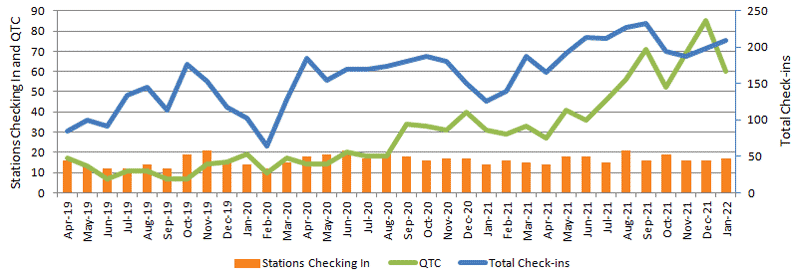
2022 is off to a great start, with much more activity on the NZ Net during January than in the same month last year. There were 209 check-ins by 17 stations, and 60 messages passed.
Here is the monthly net report, as sent to the net on 1 February.
NR5 R ZL1NZ 45/42 AUCKLAND 0800Z 2FEB22 = NZ NET = JAN QNI G3XRJ 1 VK3DRQ 11 ZL1AJY 7 ZL1ANY 21 ZL1BWG 21 ZL1NZ 21 ZL1PJH 14 ZL1RD 10 ZL2GD 13 ZL2GVA 19 ZL2IR 2 ZL2KE 11 ZL2LN 5 ZL2WT 15 ZL3TK 19 ZL4CU 3 ZL4FZ 2 ZL4KX 14 TOTAL 209 QTC 60 = ZL1NZ
Photo flashback
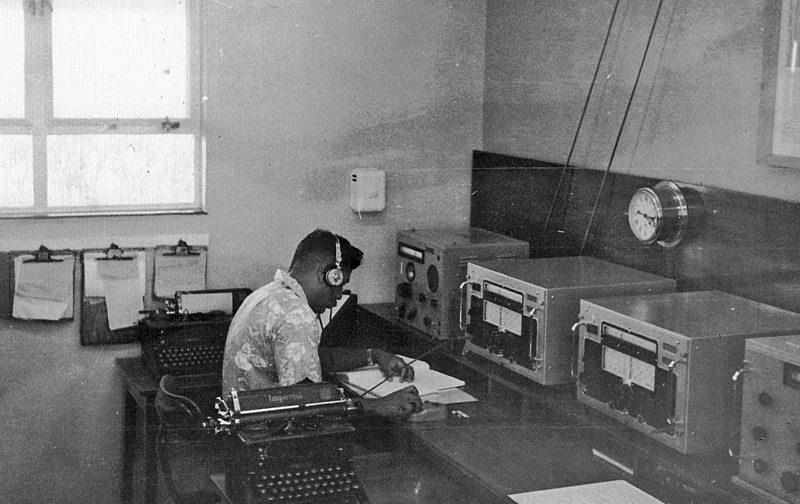
Suva Radio 3DP. Date unknown but perhaps some of our readers who know their Marconi gear could hazard a guess? See more 3DP photos at maritimeradio.org.
Gerard’s latest key project revealed

Photo: ZL2GVA
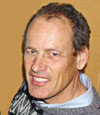 By Gerard ZL2GVA
By Gerard ZL2GVA
Here is a photo of my recently built ZL2JJ-style single-lever paddle.
So far, this key is not a 100% success.
It’s all about the pivot and return forces. I tried several things:
First, the original ZL2JJ design, with the lever rocking in a cut-out of the back pillar and being kept in place with a spring. This felt OK moving one way, but not the other.
Then I tried a bearing pivot with a spring either side of the lever, keeping it central and providing return forces. This felt very soft, understandably with the springs balancing each other in the centre position.
Then I replaced the springs with magnets, with the lever having a magnet in it and the opposing poles on either side. Again too soft.
So I had another look at the original design. I saw the spring there catching on the screw thread, so machined a pocket in the arm for it to sit in and stay free of the screw. This gave a slight improvement, but still not what I thought it should be.
Further experiments with bigger springs didn’t improve things much, so I’ll leave it for now.
Any experienced single-lever operators passing through Blenheim are kindly invited to come and try it.
More research into single lever paddles showed what Horace Martin (of Vibroplex fame) already knew 120 years ago; the action for the dits and dahs is best separated from each other, and the double pivot arm seems the best solution for this. Making a compact key becomes a bit hard with that mechanism, the Autronic key, patented in 1963 is the most compact version I’ve been able to find. I might look at making something like that at some later stage.
(The photo above shows the various parts used for the experiments; the extra holes in the base were where the springs/magnets were mounted.)
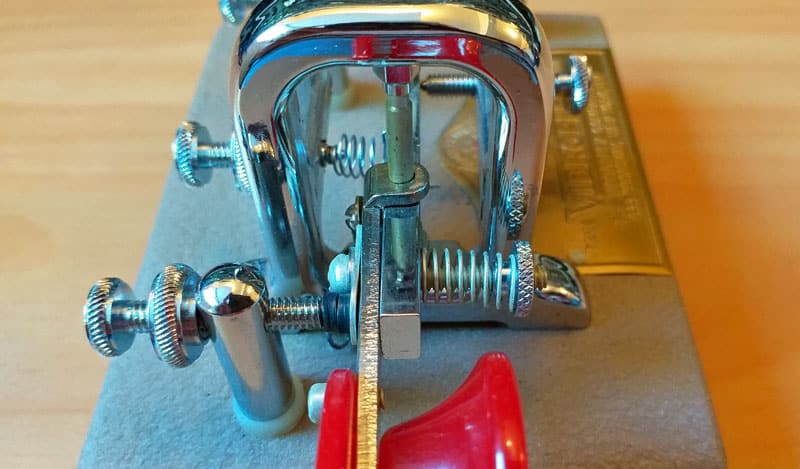
Although the Vibroplex Vibro Keyer behaves like a single-lever paddle, it actually has two semi-independent levers, as on the Vibroplex semi-automatic “bugs.” Photo: ZL1NZ
ZL2WT’s garage shack featured in new book
 Have you seen Kiwi Garages – Inside New Zealanders’ happy places, by George Lockyer?
Have you seen Kiwi Garages – Inside New Zealanders’ happy places, by George Lockyer?
George visited garages throughout the country before picking 28 of them to feature in the book. And one of those featured garages belongs to NZ Net member David ZL2WT!
Back in NZ Net News 31, David – a former ship Radio Officer – gave us a quick video tour of his shack, in which he has recreated a 1960s merchant ship radio room full of beautiful Marconi gear.
In the book, he talks about his life at sea with ships of the Royal Fleet Auxiliary, and even manages to work in a reference to certain activities happening at 2100 hours daily on the amateur bands. 🙂 (Thanks for the plug OM.)
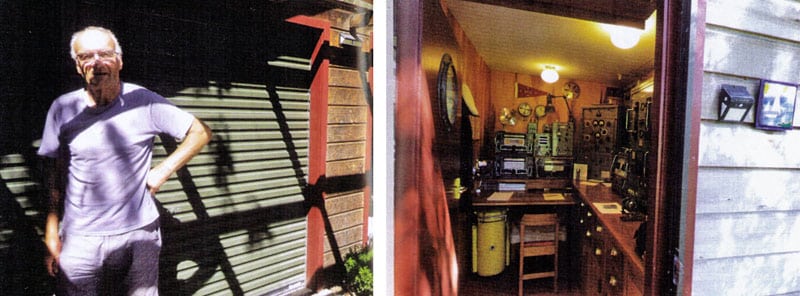
A couple of the many photos of David’s shack from Kiwi Garages
Video: Keyboard-generated Morse in 1908
At first glance it looks like a normal typewriter, and you can indeed use it that way. In addition, the clockwork mechanism opens and closes electrical contacts. A roller with Morse Code rotates inside, and when you press a key the corresponding brush touches the roller and picks up Morse code. The brush touches from the start point of the roller and is self-held until the end of one character transmission, so it is okay to release the key as the character is being generated.
Morse musings

The opinion of ZL1NZ
ANIONE as an abbreviation for ANYONE.
Seems to me that doesn’t save much time! Granted we use FER instead of FOR, but that’s a word that gets used a lot so the time savings can add up.
I suppose ANIONE makes sense if you consider that ANI is an abbreviation for ANY, so at least there’s consistency. I like NE1 but maybe that’s getting too creative.
Do you have some interesting or unusual abbreviations?
Cartoon: Gildersleeve
NZ Net goes global
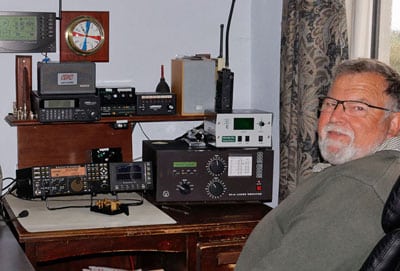 This past week we set a DX record for the net, with two check-ins by John G3XRJ (pictured) who enjoys a great radio location about 1.5km from Land’s End. The UK is about as DX as you can get from NZ, so this record will be hard to beat.
This past week we set a DX record for the net, with two check-ins by John G3XRJ (pictured) who enjoys a great radio location about 1.5km from Land’s End. The UK is about as DX as you can get from NZ, so this record will be hard to beat.
John was born a few kilometres from Land’s End and was an operator at Land’s End Radio GLD for 24 years, following a stint at Portishead Radio and four years at sea as an R/O. (Note the radio room clock in his shack photo.)
“I’m very fortunate to have maintained a quiet receiving location,” he says. “I’ve had to hunt down some QRM over the years which if I’d put up with it would have put me off the air. Luckily being local all the offenders so far have been cooperative and I continue to enjoy a quiet RX site.”
John shunt-feeds his tower for transmitting on 80m, but his not-so-secret weapon is a K9AY loop for receiving, which he installed 15 years ago.
“The receiving antenna is in waste ground 150 metres from the nearest house and its installation was the best day’s work I ever did!”
Listen to this brief recording of NZ Net, as heard in John’s shack. The stations, in order of appearance are ZL2KE (net control), ZL4KX, G3XRJ, ZL2GD and ZL3TK (the latter two returning to the net after passing traffic off-frequency).
Advertising archive

QST magazine, January 1970
Suggestions?
If you have suggestions on how to make the NZ Net better, or things you’d like to see covered in these updates, please contact ZL1NZ. You might even like to write something for the newsletter.
Thanks for reading, and I hope to hear you soon on the NZ Net!
—
Neil Sanderson ZL1NZ, Net Manager
New Zealand Net (NZ NET)
3535.0 kHz at 9pm NZT Mon-Fri



